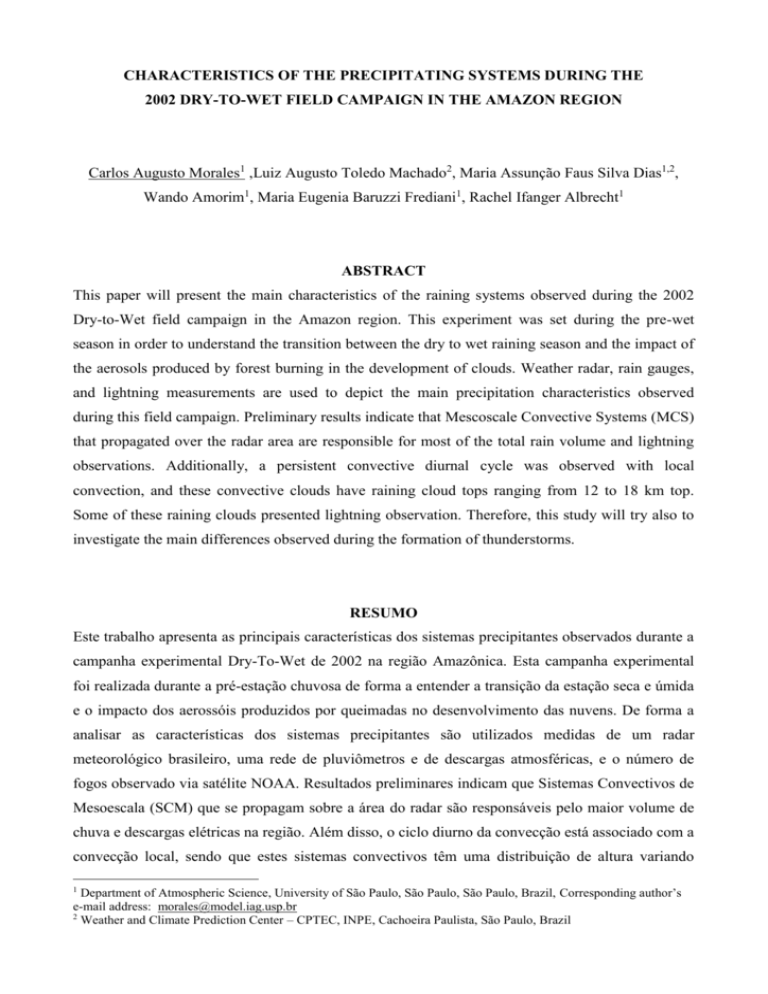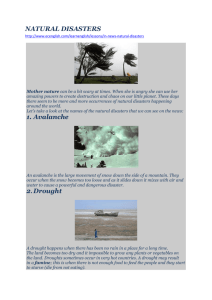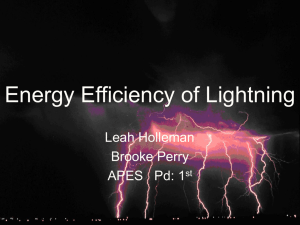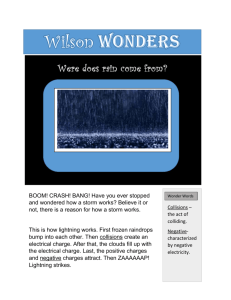INSTRUCTIONS FOR ABSTRACT PREPARATION FOR
advertisement

CHARACTERISTICS OF THE PRECIPITATING SYSTEMS DURING THE 2002 DRY-TO-WET FIELD CAMPAIGN IN THE AMAZON REGION Carlos Augusto Morales1 ,Luiz Augusto Toledo Machado2, Maria Assunção Faus Silva Dias1,2, Wando Amorim1, Maria Eugenia Baruzzi Frediani1, Rachel Ifanger Albrecht1 ABSTRACT This paper will present the main characteristics of the raining systems observed during the 2002 Dry-to-Wet field campaign in the Amazon region. This experiment was set during the pre-wet season in order to understand the transition between the dry to wet raining season and the impact of the aerosols produced by forest burning in the development of clouds. Weather radar, rain gauges, and lightning measurements are used to depict the main precipitation characteristics observed during this field campaign. Preliminary results indicate that Mescoscale Convective Systems (MCS) that propagated over the radar area are responsible for most of the total rain volume and lightning observations. Additionally, a persistent convective diurnal cycle was observed with local convection, and these convective clouds have raining cloud tops ranging from 12 to 18 km top. Some of these raining clouds presented lightning observation. Therefore, this study will try also to investigate the main differences observed during the formation of thunderstorms. RESUMO Este trabalho apresenta as principais características dos sistemas precipitantes observados durante a campanha experimental Dry-To-Wet de 2002 na região Amazônica. Esta campanha experimental foi realizada durante a pré-estação chuvosa de forma a entender a transição da estação seca e úmida e o impacto dos aerossóis produzidos por queimadas no desenvolvimento das nuvens. De forma a analisar as características dos sistemas precipitantes são utilizados medidas de um radar meteorológico brasileiro, uma rede de pluviômetros e de descargas atmosféricas, e o número de fogos observado via satélite NOAA. Resultados preliminares indicam que Sistemas Convectivos de Mesoescala (SCM) que se propagam sobre a área do radar são responsáveis pelo maior volume de chuva e descargas elétricas na região. Além disso, o ciclo diurno da convecção está associado com a convecção local, sendo que estes sistemas convectivos têm uma distribuição de altura variando Department of Atmospheric Science, University of São Paulo, São Paulo, São Paulo, Brazil, Corresponding author’s e-mail address: morales@model.iag.usp.br 2 Weather and Climate Prediction Center – CPTEC, INPE, Cachoeira Paulista, São Paulo, Brazil 1 entre 12 a 18 km de altitude, mas somente alguns destes sistemas apresentaram descargas elétricas. Portanto este estudo fará uma tentativa de se analisar as diferentes características observadas durante a formação das tempestades. 1. INTRODUCTION The Amazon region presents unique spatial and temporal rainfall variability along the year, and as one of the main sources of convection, and as a consequence, it has a major contribution in the global circulation through the release of latent heat. Several efforts, through several field campaigns, tried to understand and characterize the precipitating system. Nevertheless, most of the measurements concentrated in the wet raining season. In this paper, we present preliminary results observed during the 2002 Dry-to-Wet field campaign in the Amazon region, as a part of Radiation, Cloud, and Climate Interactions (RACCI) of LBA. This experiment was set during the pre-wet season in order to understand the transition between the dry to wet raining season and the impact of the aerosols produced by forest burning in the development of clouds. This paper gathers weather radar, rain gauges, and lightning measurements to depict the main precipitation characteristics observed during this field campaign in order to understand the transition of dry to wet raining season. In the following sections, this paper will present the characteristics of the instruments used and their quality control, and it will present the preliminary results found until the present moment. 2. DATA SET In order to characterize the precipitating systems, we used measurements of: a) one weather radar, b) a rain gauge network, and c) a cloud-to-ground lightning network. As an auxiliary data, we have used the number of forest fires. 2.1 Weather Radar Brazilian weather radar manufactured by the TECTELCOM was used in this campaign. This radar is a Doppler S-Band (2.7-3 GHz), with 2 degrees antenna aperture, with a maximum power of 750 kW, running on GAMIC operating software. The radar was installed at the central part of Rondonia State (Figure 1), in the southwestern part of the Amazon basin, with longitude of 62.4171 W, latitude of 10.9005 S at an a altitude of 433 meter. Figure 1. Map of Rondonia State in the Southwestern Amazon basin, and the location of the instruments used in the RACCI/LBA field campaign. During the experiment, 10 minutes interval volume scans with 24 elevations were realized to better describe the horizontal and vertical distribution of the precipitating systems. The period of measurements concentrated during September 16th through November 7th of 2002. Since this is the first time that this radar is been used in research, we performed several electronic calibrations to detect the stability of the measurements. Additionally, we performed an intercomparison with the Tropical Rainfall Measuring Mission (TRMM) Precipitation Radar (PR) [Kummerow et al. 1998] to depict an existence of a bias offset. The retrieval of the bias offset followed the methodology developed by Anagnostou et al. (2001) that makes an intercomparison between ground weather radars and the TRMM-PR. The methodology can be summarized as follow: a) Common 3-D grid Boxes, with 5 x 5 km horizontal resolution and 1(2) km vertical resolution; b) Intercomparison between 7 and 12 km height only, and only in grid boxes classified as stratiform rain; c) Grid-boxes with 15 and 35 dBZ; and up to 100 km from the radar; d) Finally, compute the radar reflectivity histogram difference of matched grid-boxes, mainly, Z(TECTELCOM)– Z(TRMM). Following the above methodology, we were able to find a + 6.47 dBZ bias offset, mainly the TECTELCOM overestimated the measurements, Figure 2a and 2b. Figure 2a displays the matched radar reflectivity factor distribution for both radars observing at the same time in 5 TRMM orbits. It is clear that the TECTELCOM ground radar presents a shift towards high reflectivity values. In Figure 2b, we present the radar reflectivity difference for the cases of Figure 2a, and we can see that this radar showed a bias offset. Possible causes for this type of error are still been investigated, but one possible problem is the antenna gain, that has not been computed since the first time this radar is in operation. After this bias offset correction, Constant Altitude Plan Position Indicator (CAPPI) were retrieved at 5x5 km horizontal and 1km height resolution, from 2 to 19 km altitude, for all the experiment based on weighted volume beams, Anagnostou et al. (1999). Figure 2. a) Radar reflectivity factor distribution observed by TRMM (black) and TECTELCOM (gray) on coincident grid-boxes (top); b) Histogram difference between TRMM-PR and TECTELCOM (bottom). 2.2 Rain Gauge Network A rain gauge network consisting of 29 tipping buckets have been installed around the State of Rondonia, Figure 1. The rain gauges have a temporal resolution of 10 seconds, and 0.254 mm of precipitation. Each tipping bucket have been calibrated before the installation according to the manual owners, in order to obtain 0.254 mm for each bucket. 2.3 Cloud-to-Ground Lightning Network A lightning network consisting of 4 Advanced Lightning Direction Finder (ALDF) sensors were installed by Marshall Space Flight Center (MSFC) of NASA in 1999 during the TRMM/LBA field campaign, in Guajara Mirim, Ouro Preto, Machadinho do Oeste and Vilhena, Figure 1. These sensors measure the magnectic field emitted by a lightning and detect only lightning strokes that go to ground. By measuring the magnetic field, it is possible to record the direction, strength and time of each strike. The location of a strike is found by combining the measurements from at least two sensors in the network. 2.4 Number of Fires The number of fires used in this study was retrieved by CPTEC, and can be access at: http://www.cptec.inpe.br/queimadas. The number of fire is calculated using the thermal emission channel (3.7 m) of NOAA/AVHRR satellite. 2.5 Data Access All the dataset used in this study and other datasets measured during the Wet-to-Dry 2002 Field campaign can be accessed at: http://master.iag.usp.br 3. Methodology and Results 3.1 Daily Means Daily mean time series of 35 dBZ mean height, number of fires and lightning strikes are used to seek an indication of correlation between convection in the impact of forest burning. The 35 dBZ mean height are computed from 3D CAPPIs at 5x5 km resolution in order to find the strength of the storms. It is well known that 35 dBZ between the freezing level and – 15oC, where it is a region of negative charge, is associated with the presence of lightning strokes, Toricinta et al. (1996). Therefore, the higher the level is, more vigorous the storms become. Lightning measurements can be associated with the strength of the thunderstorms, mainly because they develop the ice phase, and consequently more rain volume. Finally, number of fires are used to check how polluted the area is, and if large concentration of aerosols can be responsible for the development of giant storms, or the suppression of rain. Figure 3 displays the daily mean time series of 35 dBZ height, daily lightning strikes, and daily number of fires over an area described by 150 km far from the radar. The vertical development observed by the 35 dBZ height is very well correlated with the high incidence of lightning strikes. Nevertheless no unique relation between both parameters can be performed on a daily basis. In another hand, it is important to note that whenever we have forest burning (high values of number of fires), the 35 dBZ height levels was very low or absent, except at Julian day 267. Inspecting the meteorological maps during the days of large amount of fires, the region was over an influence of subsidence, and at the present moment no conclusions can be postulated to the effect of aerosols in the clouds. Figure 3. Time series of daily mean 35 dBz Height, daily lightning strikes, and number of fires over the radar area. 3.2 Daily Cycle The daily cycle of precipitation is first inspected by analyzing the vertical distribution of 30, 35 and 40 dBZ height as function of time, Figure 4a,b, and c. These 3 plots shows that most of the convection is concentrated around 17-19 UTC, where local convection is more intense. In addition, these convections present most of the vertical development, reaching in average 10, 8,7 km for 30, 35 and 40 dBZ respectively. Nevertheless, there are development through all day, later night and early day, but no vertical strength is found. Figure 4d presents de mean diurnal cycle of negative and positive lightning strikes and the convective fraction. Most of convective fraction is observed between 15 and 22 UTC, and note that the maximum convective fraction anticipates the maximum of lightning discharges by ~ 1 hour at least. This time lag can be explained that the maximum lightning frequency occurs during the mature stage of the thunderstorms. Finally, by comparing the negative and positive lightning discharges, we observe that most of the electrical discharges are negative, and there is a delay in the maximum frequency of positive discharges. A possible explanation for this delay could be that in general, positive lightning discharges are observed during the dissipating stage of the thunderstorms, which is confirmed by the decrease of convective fraction. Figure 4. a)top-left, mean 30 dBZ height distribution over the day; b)top-right, same as (a) but for 35 dBZ; c) bottom-left, same as (a) but for 40 dBZ; d) bottom-right, diurnal cycle of convective fraction (middle line), negative lightning strikes (top line) and positive lightning strikes. 4. CONCLUSION This paper presented an overview of the data measured during the Wet-to-Dry 2002 field campaign as part of the RACCI/LBA project. The preliminary results presented here show a strong correlation between lightning strikes and the vertical development of the 35 dBZ height. The role of the aerosols produced by biomass burning in the enhancement or the suppression of precipitation could not be achieved. Nevertheless most of the time we have fires, the area was under subsidence influence and no or little rain development was observed. Finally, the diurnal cycle analyses showed that most of the convection shows a strong component of local convection with vigorous vertical development. Afterwards, the maximum convective fraction led the maximum negative discharges that also led the positive lightning strikes. These delays are a response of the thunderstorm stage, mainly: during mature stage it is observed the maximum lightning discharges, and during the dissipating stage we observe a maximum frequency of positive strikes. 5. REFERENCES -Anagnostou, E., C.A. Morales, T. Dinku, 2001, J.A.O.Tech., 18, 4, pp. 616-628. -Anagnostou, E., V. Krajewski, Witold, 1999, J.A.O.Tech., 16, 2, 189-197. -Kummerow, C., W. Barnes, T. Kozu, J. Shiu and J. Simpson, 1998: The tropical rainfall measuring mission (TRMM) sensor package, J. Atmos. Oceanic Technol., 15, 809-817. -Toracinta, E.R., K.I. Mohr, E.J. Zipser, and R.E. Orville, 1996: A comparison of WSR-88D reflectivities, SSM/I brightness temperatures, and lightning for mesoscale convective systems in Texas. Part I: radar reflectivity and lightning. J. Appl. Meteor., 35, 902-918. 6. ACKNOWLEDGEMENTS We would like to thanks FAPESP for funding the Wet-to-Dry 2002 field campaign as a part of RACCI/LBA project, grant # 01/06901-7, and CAPES, grant #0379/2002-2004, for the financial support.








